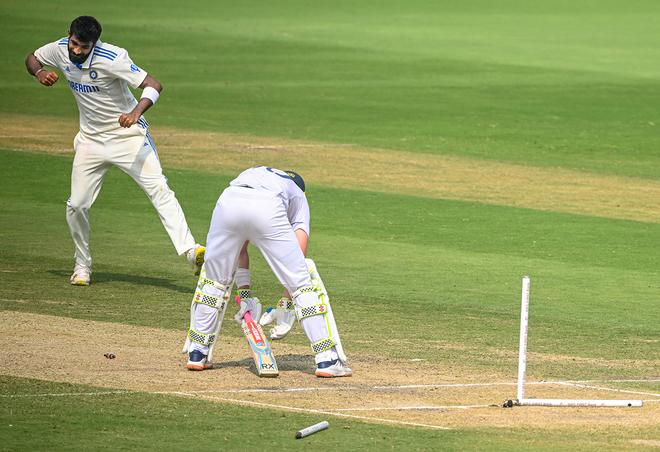Ever wondered what it must feel like to return sensational figures of three for 18 in 3.5 overs in a T20 game and still end up on the losing side? To lead the bowling charts with 18 wickets at a ridiculous economy rate of 6.20 in a tournament where 200 has been breached 32 times in 55 matches and still find your team one place off the bottom of the points table? Just ask Jasprit Bumrah.
The pacer supreme has single-handedly kept the stocks of the bowlers flying high. True, there is a logjam behind him in the list of leading wicket-takers in IPL 2024 — Harshal Patel has 17, Varun Chakaravarthy 16, Arshdeep Singh has 15 and so does T. Natarajan 15, who briefly had the temerity to snatch the Purple Cap, if only for 24 hours — but no one has quite enthralled and entranced like Bumrah, no one has asked probing questions more consistently, no one has forced batsmen to rethink their aggressive designs ball after excellent ball.
What makes Bumrah so special has been the topic of discussion for nearly a decade now. The natural hyperextension of his right elbow enables him to deliver the ball from a few inches further than anyone else, which makes length-picking extremely difficult. His high-arm action and the ability to produce different deliveries without any discernible change in action place numerous demands on batsmen, even on the flattest of decks. His speed through the air ensures that even on benign surfaces, he can seldom be taken lightly. His magnificent yorker has been dissected in detail and apart from a plethora of slower deliveries, he also possesses a mean bouncer which he uses sparingly, but to great effect.
Bumrah is clearly the premier paceman of his generation, an all-format behemoth who carries his greatness lightly.
Decoding the Bumrah puzzle
One would have thought, given how much information is available these days and how much time batsmen and analysts spend poring over the minutest of details, that the Bumrah puzzle would have been decoded by now. It’s not as if batsmen don’t know what is coming; it’s just that more often than not, even armed with that knowledge, they are caught like rabbits in a headlight, transfixed by the tiny orb of doom homing in on their toes and stumps, descending upon them as if to bruise not just limb but also ego.
Bumrah is one of those rare practitioners of a demanding craft who goes about his business with little fuss or fanfare. Even after six years of Test cricket and eight-plus years at the international level, he carries a ready smile with him, speaking to a sustained, unalloyed enjoyment of the sport. Over after unyielding over in tough conditions might take the joy out of the most positive individuals but Bumrah belongs to that rare breed that still loves the heat of a battle and that accepts without rancour that things won’t always go his way, no matter how on-point he is. When he talks, it’s as if a nuclear scientist has been asked to address kindergarten students. Much like his bowling, he tries to keep his answers simple, refusing to be drawn into technical analyses as he patiently holds forth on following the processes and not worrying about the outcome. That’s become one of the more abused cliches in competitive sport and Bumrah’s refuge in that is hardly surprising, but you often tend to overlook that because of the warmth in the heart when he is firing on all cylinders.
Bumrah was the singular difference between the sides during India’s Test series against England at home. An outstanding exhibition of reverse swing in England’s second innings in the second Test in Visakhapatnam decisively tilted the scales in India’s favour. The unplayable reversing yorker that started from well outside off and snuck under Ollie Pope’s bat to pluck two stumps out of the ground has to be one of the balls of the year. Pope had catalysed England’s fightback after conceding a 190-run deficit in the first Test in Hyderabad with a magical 196 to set himself up as the big fish for the rest of the series. Bumrah fired a telling salvo, a clear statement — ‘You might have won the battle, but no way are you winning the war’. Bumrah likes making those statements, you know. But with the ball. Only with the ball.

Test cricket is a more forgiving format, even in the Bazball era, for the bowling fraternity. There is time to regroup, batsmen don’t come hard all the while and, when there is some help for the bowlers, an even contest between bat and ball unfolds occasionally. Even in the five-day game, bowlers’ lament is that the odds are stacked against them. Imagine their plight, then, when it comes to the T20 version where, it would seem, their only role is to run in and hope that the ball only goes for four, not six.
Too much of a good thing
A recent opinion poll comprehensively supported the long-held assumption that T20 audiences would rather watch the ball sail deep into the stands on a regular basis than a low-scoring thriller. One would have thought the monotony of the ball flying long and far would have sated the appetite for unchecked ball-bashing, but apparently you can actually have too much of a good thing. Because that’s what people want, that’s what they will get — hence the pancake decks that facilitate hitting through the line without fear or favour, without respect for pedigree or reputation. Mitchell Starc, one of the premier swing exponents of all time, came into the IPL on the back of the heftiest pay cheque in the tournament’s history, at ₹ 24.75 crore. In his first two games for Kolkata Knight Riders, he had figures of none for 100 from eight overs.
THE GIST
Against this depressing (for bowlers only) backdrop, Bumrah has stood out like a beacon. Lifting the pall of gloom that has descended over the bowling fraternity, he has returned the belief. He has shown the way, he has reiterated that class will always out, no matter the format, the small boundaries, the big bats, the bigger batsmen. But then again, he is Bumrah, right? How do mere mortals go where he has gone? Without his skillsets, his versatility, his equanimity and his supreme command of his craft, how do they even start to think wickets when batsmen are charging at them, impervious to whether the ball is coming at them at 120 kmph or 150?
And that’s why Bumrah is Bumrah. That’s why he is what he his — the first, but not among equals because, truth to tell, there are no equals for Bumrah at the current time. Occasionally, some others will have a good run, a few good games on the trot, even maybe in more than one format. But eventually, they will cop punishment. They will be taken to the cleaners. They will be put in their place, their audacity in trying to gatecrash the batsmen’s party buried in a heap of misery and destruction. But not Bumrah.
If he gets smashed — he will too, make no mistake — Bumrah will spring back immediately, like the Indian rubber man. He will shrug off one expensive over, one forgettable match, and return stronger, more lethal, more potent, more dangerous. As he has done in this IPL.
Jake Fraser-McGurk took 18 off his first over in Delhi Capitals’ showdown against Mumbai Indians; Bumrah finished with one for 35 in that game. That’s also the exact number of runs he conceded in eight overs combined in his next two outings. Why? Because that’s how good he is.

MI is all but out of the running for a playoff berth, having lost eight of 12 games in Hardik Pandya’s first season as its captain. But that will matter little to Bumrah. He has two more matches, a maximum of eight overs, before he can put his feet up, deservedly, and start looking ahead to the T20 World Cup in the US and the Caribbean. Not for the first time, he will be the lynchpin around whom India’s bowling fortunes will revolve. Even if, as expected, the pitches in the Americas play low and slow and favour the spinners more, Bumrah won’t be a non-factor. Not by a long way. Bumrah? Non-factor? Same breath? Crazy, right?
Bumrah belongs to that generation of Indian cricketers who haven’t won a global title for 11 years now. India’s last meaningful silverware came at the 2013 Champions Trophy in England, when Bumrah was still wheeling away in various Gujarat outposts, yet to catch MI talent scout John Wright’s eye. Even more than his captain Rohit Sharma and Virat Kohli, who were both in that Champions Trophy-winning side and who both are World Cup winners, Bumrah will be determined to not merely stamp his class on the T20 World Cup but also carry his side to the Promised Land. He knows better than anyone else that time isn’t a fast bowler’s ally, so why wait any longer for a shot at glory? Why not have a go now? Why? Because Bumrah can, that’s why.







